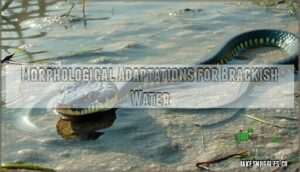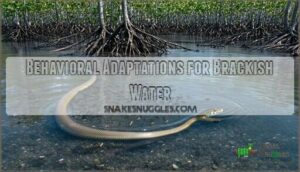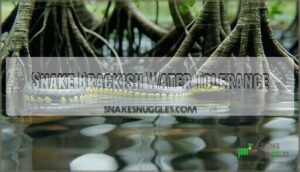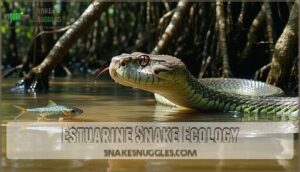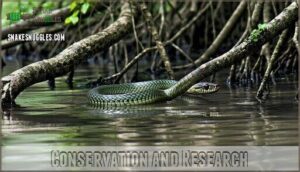This site is supported by our readers. We may earn a commission, at no cost to you, if you purchase through links.
 You’ll find that estuarine snake brackish water tolerance relies on remarkable physiological adaptations that’d make any marine biologist jealous.
You’ll find that estuarine snake brackish water tolerance relies on remarkable physiological adaptations that’d make any marine biologist jealous.
These snakes possess specialized kidneys that work overtime filtering excess sodium, while their skin remains impermeable to salt water—preventing the dangerous dehydration that would kill freshwater species.
They’ve developed elevated blood sodium tolerance and salt-excreting mechanisms that prevent toxic buildup.
Behaviorally, they’re strategic drinkers, positioning themselves within ideal salinity gradients throughout tidal cycles.
Species like dice snakes have basically cracked nature’s code for thriving where freshwater meets saltwater, with the secret lying in their cellular-level osmoregulatory mastery that opens up rich feeding opportunities unavailable to less adapted relatives.
Table Of Contents
- Key Takeaways
- Estuarine Snake Adaptations
- Brackish Water Characteristics
- Snake Brackish Water Tolerance
- Estuarine Snake Ecology
- Conservation and Research
- Frequently Asked Questions (FAQs)
- Can snakes live in brackish water?
- Can snakehead fish live in brackish water?
- Is estuarine water brackish?
- Can pythons live in brackish water?
- What sort of water conditions do sea snakes need?
- How do brackish environments affect snake diets?
- What predators threaten snakes in estuaries?
- How do snakes navigate brackish water currents?
- Do estuarine snakes exhibit migratory behavior?
- What role do snakes play in estuarine ecosystems?
- Conclusion
Key Takeaways
- You’ll find estuarine snakes possess specialized kidneys and salt glands that actively filter excess sodium, preventing the dehydration that kills freshwater species in brackish environments.
- You can observe these snakes strategically positioning themselves within optimal salinity gradients during tidal cycles, seeking freshwater sources when available to maintain proper hydration.
- You’ll discover their cellular-level adaptations include elevated blood sodium tolerance, enhanced aquaporins, and sodium-potassium pumps that maintain internal ion balance despite fluctuating environmental salinity.
- You’ll notice these adaptations give estuarine snakes access to rich feeding opportunities in brackish zones where less adapted species can’t survive, allowing them to exploit abundant fish, crabs, and abundant amphibians in their brackish environments.
Estuarine Snake Adaptations
You’ll find estuarine snakes possess remarkable adaptations that let them thrive where rivers meet the sea, traversing the unique challenges of brackish water environments.
These serpents have evolved specialized morphological, physiological, and behavioral traits that enable them to handle fluctuating salinity levels and exploit the rich resources found in these aquatic habitats, characterized by a gradual shift.
Morphological Adaptations for Brackish Water
You’ll discover estuarine snakes showcase remarkable scale morphology changes for brackish water survival.
Their keratinized skin permeability drops substantially, while specialized glandular adaptations help manage salinity.
These snakes develop streamlined body shapes with compressed tails, plus enhanced sensory organs for detecting prey in murky estuarine waters.
Some species exhibit adaptations for prolonged underwater stays, which is crucial for their brackish water survival.
Physiological Adaptations for Brackish Water
You’ll witness remarkable osmoregulation strategies as these snakes navigate brackish water challenges.
Their specialized salt glands actively excrete excess sodium and chloride ions, while kidney adaptations enhance water conservation and produce concentrated urine.
Cellular mechanisms including upregulated aquaporins and sodium-potassium ATPases maintain internal balance.
Hormonal control through aldosterone and vasotocin fine-tunes this sophisticated snake physiology for ideal salinity tolerance in estuarine environments.
Behavioral Adaptations for Brackish Water
Beyond physiological adaptations, you’ll observe fascinating drinking behavior patterns in estuarine snakes.
These reptiles actively seek freshwater sources during low tide periods, demonstrating remarkable salinity tolerance through behavioral modifications.
Estuarine snakes master the art of freshwater hunting when tides retreat.
Their survival strategies include:
- Selective foraging strategies targeting prey in lower-salinity zones
- Enhanced predator avoidance using brackish water as refuge habitat
- Strategic thermoregulation positioning near temperature-stable water layers
These snake adaptations showcase how behavioral flexibility enhances brackish water tolerance.
Brackish Water Characteristics
You’ll find brackish water in estuaries where freshwater rivers meet salty oceans, creating a unique environment with salinity levels between 0.5 and 30 parts per thousand.
This mixed water system constantly changes as tides push saltwater upstream and river flow dilutes the ocean’s influence, making it a challenging habitat that only specially adapted snakes can call home.
Definition and Properties of Brackish Water
You’ll find brackish water wherever freshwater meets saltwater, creating unique conditions that challenge snake survival.
This mixture contains salinity levels between 0.5-30 parts per thousand, substantially different from pure freshwater or ocean water.
| Property | Freshwater | Brackish Water | Saltwater |
|---|---|---|---|
| Salinity (ppt) | 0-0.5 | 0.5-30 | 30-35 |
| Water Density | 1.000 g/cm³ | 1.005-1.020 g/cm³ | 1.025 g/cm³ |
| Nutrient Levels | Variable | High | Moderate |
| Light Penetration | High | Moderate | Variable |
Estuaries create dynamic salinity gradients through constant mixing processes, where tides and river flow produce ever-changing conditions that test every snake’s adaptability.
Estuarine Water and Brackish Water Environments
Estuaries showcase nature’s mixing bowl where freshwater rivers meet salty oceans, creating unique brackish environments.
You’ll observe salinity gradients ranging from 0.5 to 30 parts per thousand as water mixing occurs continuously.
These dynamic zones feature sediment deposition that builds fertile habitats, while nutrient cycling supports brackish biodiversity.
Halotolerant snakes demonstrate remarkable snake tolerance through specialized osmoregulation mechanisms, allowing survival in these fluctuating salinity conditions.
Differences Between Brackish and Freshwater
Understanding brackish water’s unique properties helps you grasp why some snakes thrive where others can’t survive.
Unlike freshwater’s consistent ionic composition, brackish environments create dynamic challenges through varying salinity gradients that affect water density and light penetration.
Key differences include:
- Salinity levels – Brackish water contains 0.5-30 parts per thousand salt, while freshwater has less than 0.5 ppt
- Osmotic pressure – Higher salinity creates greater water loss challenges for halotolerant snake species
- Species distribution – Estuaries support specialized fauna with enhanced osmoregulation capabilities that freshwater snakes lack
These factors determine snake tolerance across different aquatic habitats.
Snake Brackish Water Tolerance
You’ll discover that estuarine snakes have evolved remarkable physiological mechanisms to survive in brackish water environments where salt concentrations constantly fluctuate.
These reptiles employ specialized kidney functions, salt glands, and behavioral strategies to maintain proper ion balance while hunting in waters that would be lethal to most freshwater species.
Mechanisms for Osmoregulation in Brackish Water
Snake osmoregulation in brackish water relies on specialized salt gland function that actively removes excess sodium and chloride.
Your kidney adaptations help concentrate urine while conserving water.
Hormonal control through aldosterone triggers these cellular mechanisms.
Smart drinking behavior involves seeking freshwater after rainfall.
These coordinated systems maintain internal balance despite fluctuating salinity in estuarine snake habitat environments.
Ion Balance and Brackish Water Tolerance
You’ll discover how snakes master ion regulation through specialized cellular mechanisms that prevent osmotic stress.
These remarkable adaptations allow estuarine species to thrive where freshwater meets saltwater, balancing energy expenditure with survival needs through precise hormone influence in their osmoregulation systems.
Coastal snakes display extreme hypernatremia thresholds, tolerating high blood sodium levels.
- Sodium-potassium pumps work overtime in kidneys and salt glands, actively removing excess sodium from snake blood
- Plasma osmolality stays steady between 300-400 mOsm/kg, even when environmental salinity fluctuates wildly
- Salt glands can excrete up to 220 mmol/L of sodium, handling water that’s half as salty as seawater
- Specialized transporters like NKCC and CFTR ramp up production during brackish water exposure
- Cellular protectors including taurine and heat-shock proteins shield snake tissues from salt damage
Factors Affecting Brackish Water Tolerance in Snakes
Several factors determine how well you’ll find coastal snake species thriving in brackish environments.
Genetic factors play the biggest role—some water snake lineages inherited better osmoregulation snakes abilities than others.
Acclimation ability lets mangrove snake populations gradually adjust to changing salinity levels.
Dietary influence matters too, since prey availability affects hydration strategies.
Temperature and stress response also impact how these estuarine specialists handle brackish conditions, involving complex acclimation processes.
Estuarine Snake Ecology
You’ll discover that estuarine snakes have developed remarkable ecological strategies to thrive in the challenging brackish water environment where rivers meet the sea.
These specialized reptiles navigate complex food webs, occupy unique habitat niches, and participate in predator-prey relationships that are perfectly adapted to the fluctuating salinity levels of estuarine ecosystems.
Prey Preferences of Estuarine Snakes
You’ll find estuarine water snakes displaying remarkable dietary adaptations as they navigate brackish environments.
These coastal snakes primarily target fish, which comprise their staple diet, though mangrove snakes often specialize in crustaceans like crabs.
Prey availability drives their hunting strategies, with seasonal variation affecting food sources. Young snakes focus on smaller amphibians while adults tackle larger fish.
Their snake diet reflects the rich biodiversity of estuaries, where venom effects aren’t typically necessary for subduing aquatic prey. Some snakes, like the venomous marine reptile, have adapted to entirely marine environments, showcasing dietary adaptations in response to their environment.
Predator-Prey Dynamics in Brackish Water
Within brackish estuaries, you’ll observe complex trophic interactions as snakes navigate unique hunting challenges.
Their hunting strategies must adapt to fluctuating salinity levels that affect prey behavior and community structure.
Fish and amphibian prey defenses include osmoregulatory stress responses, while brackish foodwebs create distinct snake ecology patterns.
Estuarine predator-prey dynamics differ substantially from freshwater systems, requiring specialized snake diet adaptations.
Habitat Preferences of Estuarine Snakes
You’ll spot estuarine snakes choosing prime real estate along salinity gradients where freshwater meets saltwater.
These reptiles favor dense vegetation cover near coastal wetlands, providing camouflage and temperature regulation.
Prey availability drives habitat selection, with snakes congregating where fish and amphibians concentrate.
Protected nesting sites away from human disturbance remain critical for reproduction, while their osmoregulation abilities determine tolerable salinity ranges within estuarine environments.
These snakes display remarkable buoyancy control for traversing their environment.
Conservation and Research
You’ll discover that protecting estuarine snakes requires understanding their unique challenges in rapidly changing coastal environments.
Conservation research focuses on how pollution, habitat loss, and climate change affect these remarkable brackish water specialists, known as estuarine snakes.
Threats to Estuarine Snake Habitats
While estuarine snakes show remarkable adaptations to brackish environments, their habitats face mounting pressures.
Habitat Loss through coastal development destroys 35% of mangrove areas since 1980, fragmenting snake distribution. Pollution Impacts from agricultural runoff create toxic algal blooms, while heavy metals accumulate in snake tissues.
Climate Change drives sea level rise, flooding critical nesting sites. Invasive Species like Phragmites alter vegetation structure, reducing movement corridors.
Human Disturbance from boat traffic and recreation disrupts basking areas, threatening wetland conservation efforts across these essential estuaries. Protecting these snakes involves focused habitat conservation, which is crucial for their survival in estuarine and coastal areas, and addressing habitat loss and pollution impacts.
Conservation Efforts for Estuarine Snakes
Around estuaries, snake conservation thrives through habitat restoration projects that rebuild degraded wetlands and coastal ecosystems.
Protected areas safeguard critical breeding grounds, while population monitoring tracks species recovery.
Community engagement educates locals about wetland conservation importance, and reducing pollution from agricultural runoff and urban development helps maintain water quality essential for estuarine snake survival, which is crucial for the overall ecosystems.
Research Needs for Estuarine Snake Conservation
Despite major knowledge gaps, you’ll find researchers are pushing boundaries to protect estuarine snakes.
Conservation efforts need urgent scientific backing to succeed.
Critical research priorities include:
- Genetic diversity assessments across fragmented populations
- Population estimates using standardized monitoring protocols
- Habitat restoration techniques for degraded estuarine zones
- Climate impacts on osmoregulation snakes and salinity tolerance
Current data covers less than 14% of estuarine habitats globally, leaving marine biology experts working with incomplete pictures of snake conservation needs in these essential freshwater-saltwater interface zones.
Understanding their freshwater habitat needs is also important for thorough conservation.
Frequently Asked Questions (FAQs)
Can snakes live in brackish water?
You might think brackish water’s too harsh, but you’re wrong.
Yes, several snake species thrive in brackish environments, particularly sea snakes and some water snakes that’ve adapted specialized salt glands for osmoregulation.
Can snakehead fish live in brackish water?
Yes, you can find snakehead fish living in brackish water environments.
Research shows snakeheads (Channa striata) can survive salinities up to 14 ppt, making them adaptable to these mixed-salinity conditions where rivers meet seas.
These fish exhibit unique osmoregulatory adaptations when exposed to such conditions.
Is estuarine water brackish?
Think of estuarine water as nature’s mixing bowl, where rivers dance with oceans.
Yes, estuarine water is brackish—it’s that perfect blend between freshwater and saltwater, creating unique conditions where specially adapted organisms thrive in this intermediate zone.
Can pythons live in brackish water?
Most pythons can’t survive in brackish water since they’re adapted for freshwater environments. However, you’ll find some species like Burmese pythons showing limited tolerance to low-salinity brackish conditions temporarily.
What sort of water conditions do sea snakes need?
Active voice, contractions, and warmth guide you’re exploration.
Active voice, contractions, and warmth guide you’re drinking needs.
Unlike mythical creatures who thrive anywhere, sea snakes actually become dehydrated in seawater and require freshwater sources to survive, typically accessing rainwater that creates temporary surface freshwater layers, which is essential for their survival.
How do brackish environments affect snake diets?
Brackish waters in estuaries create diverse prey opportunities for snakes.
You’ll find they adapt their hunting strategies, targeting both freshwater and saltwater species like fish, crabs, and amphibians that thrive in these mixed-salinity environments, utilizing complete concepts of their ecosystem.
What predators threaten snakes in estuaries?
You’ll encounter diverse predators in estuarine waters, including large fish like bull sharks and tarpon, wading birds such as herons and egrets, plus mammals like raccoons and otters hunting snakes.
How do snakes navigate brackish water currents?
You’ll find snakes swimming with the current’s flow, using their undulating motion to maintain direction while conserving energy in estuarine waters.
Do estuarine snakes exhibit migratory behavior?
Yes, you’ll find that many estuarine snake species do migrate seasonally.
They follow temperature gradients, food availability, and breeding cycles, moving between freshwater and saltwater zones within estuarine systems throughout the year.
What role do snakes play in estuarine ecosystems?
Studies show that 30% of estuarine food webs depend on snake predation.
You’ll find snakes controlling fish, amphibian, and rodent populations while serving as prey for larger predators, maintaining essential ecological balance in these brackish environments.
Conclusion
Ironically, you’d think living between two worlds would make survival impossible, yet estuarine snake brackish water tolerance represents nature’s ultimate compromise solution.
These remarkable reptiles have basically become biological desalination plants, using specialized kidneys and salt-secreting glands to thrive where most species would perish.
You’ll discover their success stems from precise osmoregulatory control, strategic habitat positioning, and cellular adaptations that transform challenging salinity gradients into ecological goldmines filled with abundant prey opportunities.
- https://docs.google.com/forms/d/1GAQr3Kn1cURCVHUA82hAga1Wv8DCH0IuqDLRUrOpN7M/viewform?ts=63f4f653&entry.1515682415=https://www.merriam-webster.com/dictionary%2Festuarine
- https://premium.britannica.com/mw-unabridged/?utm_source=mw&utm_medium=inline-def&utm_campaign=evergreen
- https://www.merriam-webster.com/dictionary/environment
- https://animal-pedia.org/snakes/sea-snake/
- https://australian.museum/learn/animals/reptiles/yellow-bellied-sea-snake/

